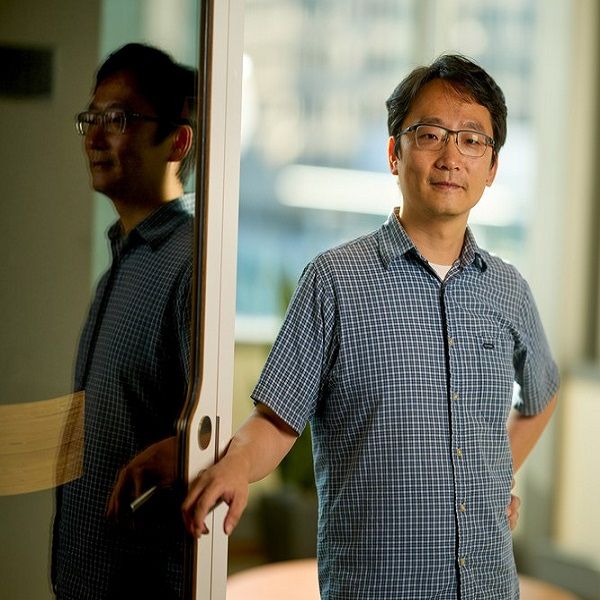When you picture MIT doctoral students taking small PhD courses together, you probably don’t imagine them going on class field trips. But it does happen, sometimes, and one of those trips changed Andy Sun’s career.
Today, Sun is a faculty member at the MIT Sloan School of Management and a leading global expert on integrating renewable energy into the electric grid. Back in 2007, Sun was an operations research PhD candidate with a diversified academic background: He had studied electrical engineering, quantum computing, and analog computing but was still searching for a doctoral research subject involving energy.
One day, as part of a graduate energy class taught by visiting professor Ignacio J. Pérez Arriaga, the students visited the headquarters of ISO-New England, the organization that operates New England’s entire power grid and wholesale electricity market. Suddenly, it hit Sun. His understanding of engineering, used to design and optimize computing systems, could be applied to the grid as a whole, with all its connections, circuitry, and need for efficiency.
“The power grids in the U.S. continent are composed of two major interconnections, the Western Interconnection, the Eastern Interconnection, and one minor interconnection, the Texas grid,” Sun says. “Within each interconnection, the power grid is one big machine, essentially. It’s connected by tens of thousands of miles of transmission lines, thousands of generators, and consumers, and if anything is not synchronized, the system may collapse. It’s one of the most complicated engineering systems.”
And just like that, Sun had a subject he was motivated to pursue. “That’s how I got into this field,” he says. “Taking a field trip.”
Sun has barely looked back. He has published dozens of papers about optimizing the flow of intermittent renewable energy through the electricity grid, a major practical issue for grid operators, while also thinking broadly about the future form of the grid and the process of making almost all energy renewable. Sun, who in 2022 rejoined MIT as the Iberdrola-Avangrid Associate Professor in Electric Power Systems, and is also an associate professor of operations research, emphasizes the urgency of rapidly switching to renewables.
“The decarbonization of our energy system is fundamental,” Sun says. “It will change a lot of things because it has to. We don’t have much time to get there. Two decades, three decades is the window in which we have to get a lot of things done. If you think about how much money will need to be invested, it’s not actually that much. We should embrace this future that we have to get to.”
Successful operations
Unexpected as it may have been, Sun’s journey toward being an electricity grid expert was informed by all the stages of his higher education. Sun grew up in China, and received his BA in electronic engineering from Tsinghua University in Beijing, in 2003. He then moved to MIT, joining the Media Lab as a graduate student. Sun intended to study quantum computing but instead began working on analog computer circuit design for Professor Neil Gershenfeld, another person whose worldview influenced Sun.
“He had this vision about how optimization is very important in things,” Sun says. “I had never heard of optimization before.”
To learn more about it, Sun started taking MIT courses in operations research. “I really enjoyed it, especially the nonlinear optimization course taught by Robert Freund in the Operations Research Center,” he recalls.
Sun enjoyed it so much that after a while, he joined MIT’s PhD program in operations research, thanks to the guidance of Freund. Later, he started working with MIT Sloan Professor Dimitri Bertsimas, a leading figure in the field. Still, Sun hadn’t quite nailed down what he wanted to focus on within operations research. Thinking of Sun’s engineering skills, Bertsimas suggested that Sun look for a research topic related to energy.
“He wasn’t an expert in energy at that time, but he knew that there are important problems there and encouraged me to go ahead and learn,” Sun says.
So it was that Sun found himself in ISO-New England headquarters one day in 2007, finally knowing what he wanted to study, and quickly finding opportunities to start learning from the organization’s experts on electricity markets. By 2011, Sun had finished his MIT PhD dissertation. Based in part on ISO-New England data, the thesis presented new modeling to more efficiently integrate renewable energy into the grid; built some new modeling tools grid operators could use; and developed a way to add fair short-term energy auctions to an efficient grid system.
The core problem Sun deals with is that, unlike some other sources of electricity, renewables tend to be intermittent, generating power in an uneven pattern over time. That’s not an insurmountable problem for grid operators, but it does require some new approaches. Many of the papers Sun has written focus on precisely how to increasingly draw upon intermittent energy sources while ensuring that the grid’s current level of functionality remains intact. This is also the focus of his 2021 book, co-authored with Antonio J. Conejo, “Robust Optimiziation in Electric Energy Systems.”
“A major theme of my research is how to achieve the integration of renewables and still operate the system reliably,” Sun says. “You have to keep the balance of supply and demand. This requires many time scales of operation from multidecade planning, to monthly or annual maintenance, to daily operations, down through second-by-second. I work on problems in all these timescales.”
“I sit in the interface between power engineering and operations research,” Sun says. “I’m not a power engineer, but I sit in this boundary, and I keep the problems in optimization as my motivation.”
Culture shift
Sun’s presence on the MIT campus represents a homecoming of sorts. After receiving his doctorate from MIT, Sun spent a year as a postdoc at IBM’s Thomas J. Watson Research Center, then joined the faculty at Georgia Tech, where he remained for a decade. He returned to the Institute in January of 2022.
“I’m just very excited about the opportunity of being back at MIT,” Sun says. “The MIT Energy Initiative is a such a vibrant place, where many people come together to work on energy. I sit in Sloan, but one very strong point of MIT is there are not many barriers, institutionally. I really look forward to working with colleagues from engineering, Sloan, everywhere, moving forward. We’re moving in the right direction, with a lot of people coming together to break the traditional academic boundaries.”
Still, Sun warns that some people may be underestimating the severity of the challenge ahead and the need to implement changes right now. The assets in power grids have long life time, lasting multiple decades. That means investment decisions made now could affect how much clean power is being used a generation from now.
“We’re talking about a short timeline, for changing something as huge as how a society fundamentally powers itself with energy,” Sun says. “A lot of that must come from the technology we have today. Renewables are becoming much better and cheaper, so their use has to go up.”
And that means more people need to work on issues of how to deploy and integrate renewables into everyday life, in the electric grid, transportation, and more. Sun hopes people will increasingly recognize energy as a huge growth area for research and applied work. For instance, when MIT President Sally Kornbluth gave her inaugural address on May 1 this year, she emphasized tackling the climate crisis as her highest priority, something Sun noticed and applauded.
“I think the most important thing is the culture,” Sun says. “Bring climate up to the front, and create the platform to encourage people to come together and work on this issue.”
Source: MIT










